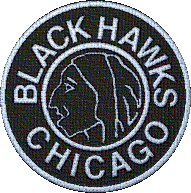

|
On September 25, 1926, Major Frederic McLaughlin was granted approval by the National Hockey League to form a team to begin competing in the 1926-27 season. McLaughlin had made his fortune in the coffee industry. He wanted his team to be competitive from the start, so he purchased the Portland Rosebuds from Lester Patrick for $200,000. The whole team was available because, the league they competed in was folding. Major McLaughlin chose the name Blackhawks for his team. There are a couple of different stories about why he chose that name. The first one says that during World War I, McLaughlin had served as commander of the 333rd Machine-Gun Battalion of the 85th (Blackhawk) division of the U.S. Army. The division's nickname commemorated Black Hawk, a prominent Indian of the early 1800's, so McLaughlin chose the Blackhawks for the team's name in honor of his military unit. The second story says that the Major had a restaurant in Chicago called The Blackhawk and he named the team the Blackhawks to get a little free advertising for his restaurant. There's probably a little truth to both stories. Until 1986, the team's name had always been written as two words (Black Hawks). That year, owner Bill Wirtz officially changed the spelling to conform to Chicago's original charter of 1926. The name was mis-written on everything from League scoresheets to club publicity for 60 years. The team's sweaters were designed by Major McLaughlin's wife. The early games were a social event and were attended mostly by the rich. They viewed the games as a novelty. The Blackhawks played their first game on November 17, 1926, against the Toronto St. Patrick's. Although they won this first game by a score of 4-1, the Blackhawks record that year was a dismal 19-22-3 and they lost in the first round of the playoffs. Their record got even worse as they had a combined record of 35-81-16 over the next three seasons. The Blackhawks played their home games in the Chicago Coliseum until they moved into the newly completed Chicago Stadium on December 16, 1929. |